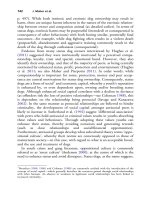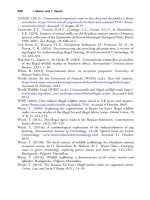The palgrave international handbook of a 300
Bạn đang xem bản rút gọn của tài liệu. Xem và tải ngay bản đầy đủ của tài liệu tại đây (40.82 KB, 1 trang )
Hunting and Shooting: The Ambiguities of ‘Country Sports’
297
management practices of the shooting estates had impinged negatively upon
local communities, public amenities and, in particular, other animal species
and their habitats. Evidence from the Grampian Fire and Rescue Service to the
LRRG, in particular, confirmed that during 2011–2013 a third of the wildfires
attended by the Service resulted from supposedly ‘controlled’ grouse moor
burnings which had got out of control (LRRG 2014, p. 171). In other areas,
the over-breeding of deer for shooting has caused problems for farmers and
other land users. Yet, above all, it has been the impact of the large grouse
shooting estates which have attracted the most enduring criticisms. Even from
the late nineteenth-century, the rapid expansion of the shooting estates was
considered to be primarily responsible for the widespread persecution of a range
of bird species (especially birds of prey) as well as a variety of mammals thought
to be a threat to game bird populations (Lister-Kaye 1994). In more recent
years, the management of land for high-density game-bird yields, especially on
grouse moors has been blamed for the continuing practice of gamekeepers
poisoning rare birds of prey (RSPB 2003), even though this practice was
outlawed in 1912.4 As Whitfield et al. have concluded, ‘illegal poisoning in
the uplands of Scotland occurs disproportionately on land actively managed as
grouse moor’ (2003, p. 162).
In Scotland, between 1989 and 2008, some 450 birds of prey were killed
by illegal poisoning, and a further 320 were shot or trapped and their nests
destroyed in what RSPB Scotland have referred to as ‘twenty years of
relentless human killing of Scotland’s protected bird of prey species’
(RSPB Scotland 2009). The fact that the Scottish grouse moors, where a
majority of these killings occurred, comprise some of the more remote and
under-populated areas of mainland Britain and that most only came to
light almost by accident when reported by walkers or birdwatchers, strongly
suggests that the known incidents are but a small proportion of a much
larger total. According to the Scottish Raptor Study Group (1997), confirmed incidents reflect just the tip of an iceberg; a view supported by the
findings of a recent study which compared unpublished ‘vermin’ destruction records from one estate in Perthshire with incidents for the whole of
Scotland as recorded by the authorities. ‘The results showed that over a
4
The setting of poison baits in the open was first prohibited in 1912, under the Protection of Animals
(Scotland) Act in 1912. The legislation did not include specific legal protection for birds which only
came in 1954 when the persecution of raptors (including poisoning, trapping and shooting) was
prohibited by the Protection of Birds Act. Despite this, populations of many birds of prey are
significantly constrained in parts of Scotland as a result of continuing illegal persecution. See http://
www.scottishraptorstudygroup.org/persecution.html









